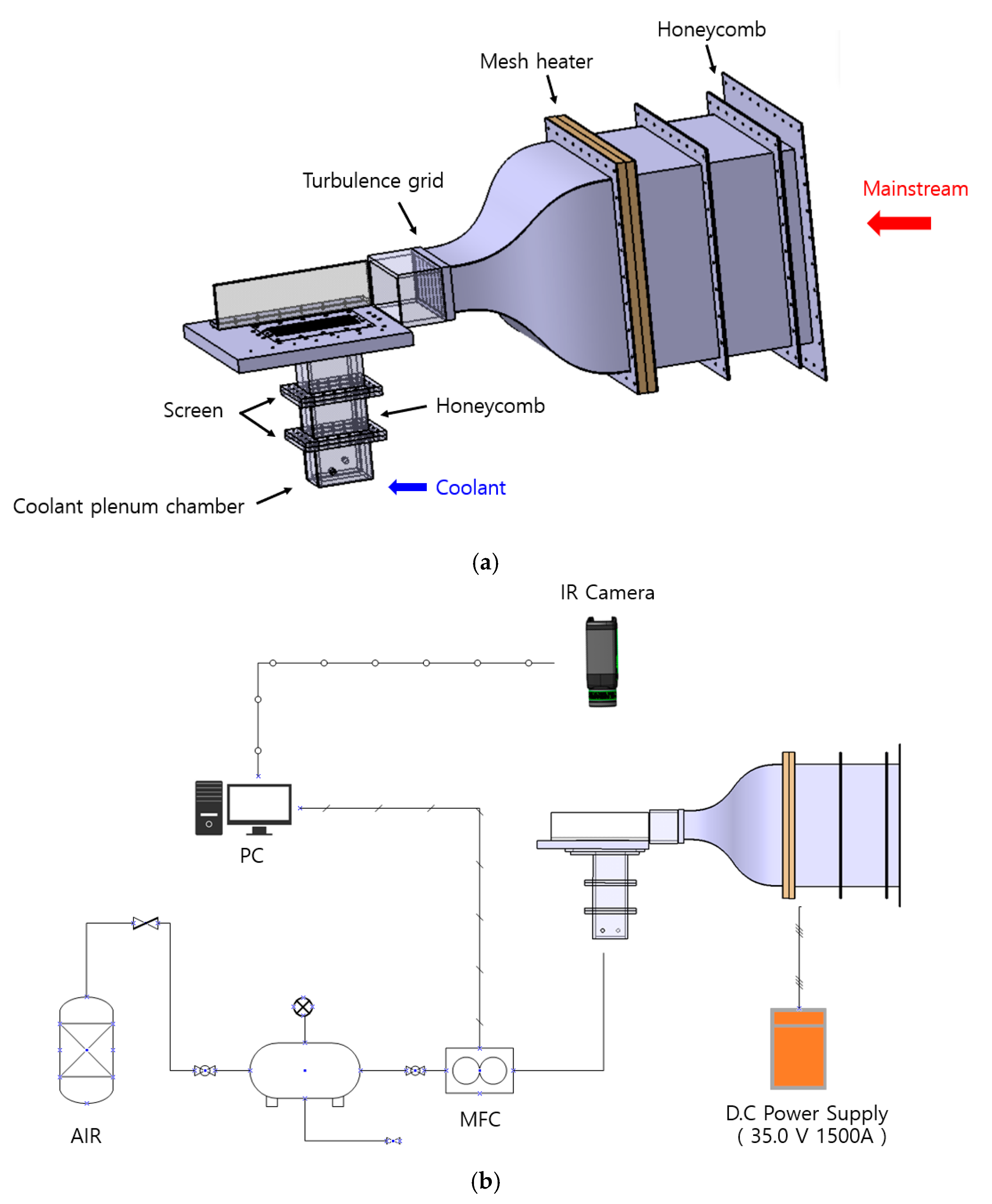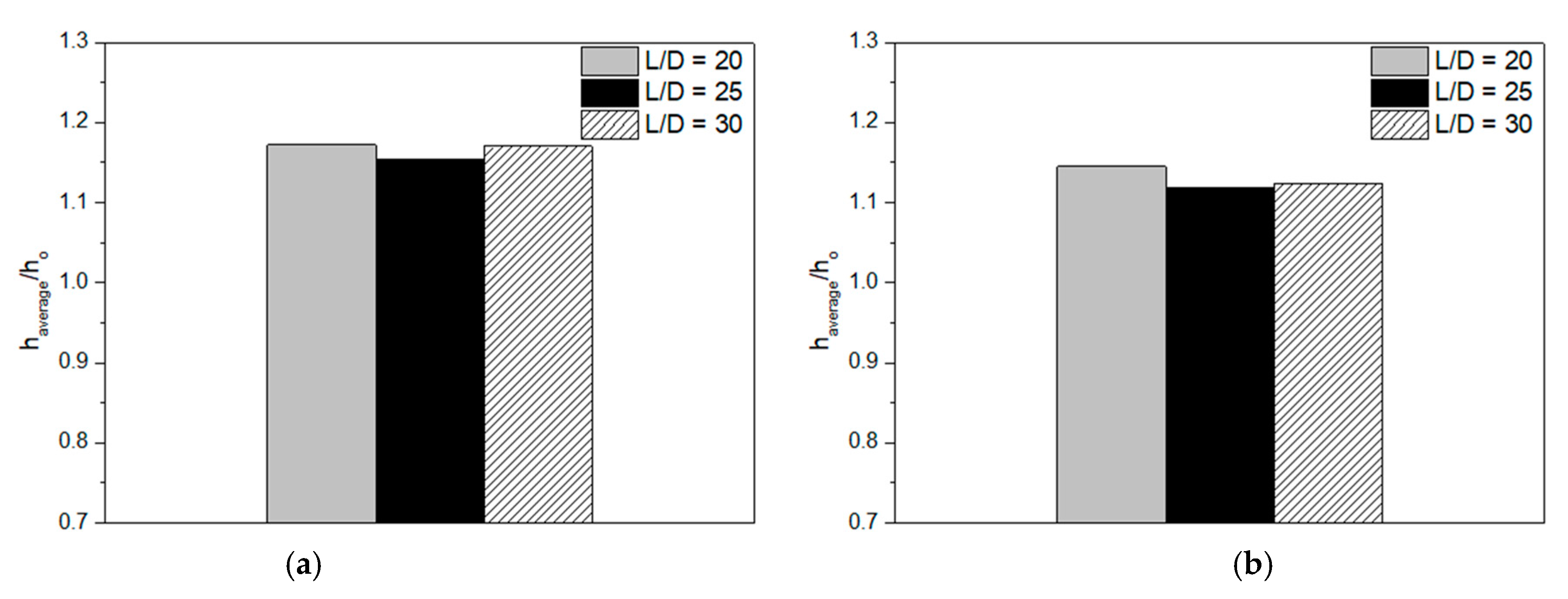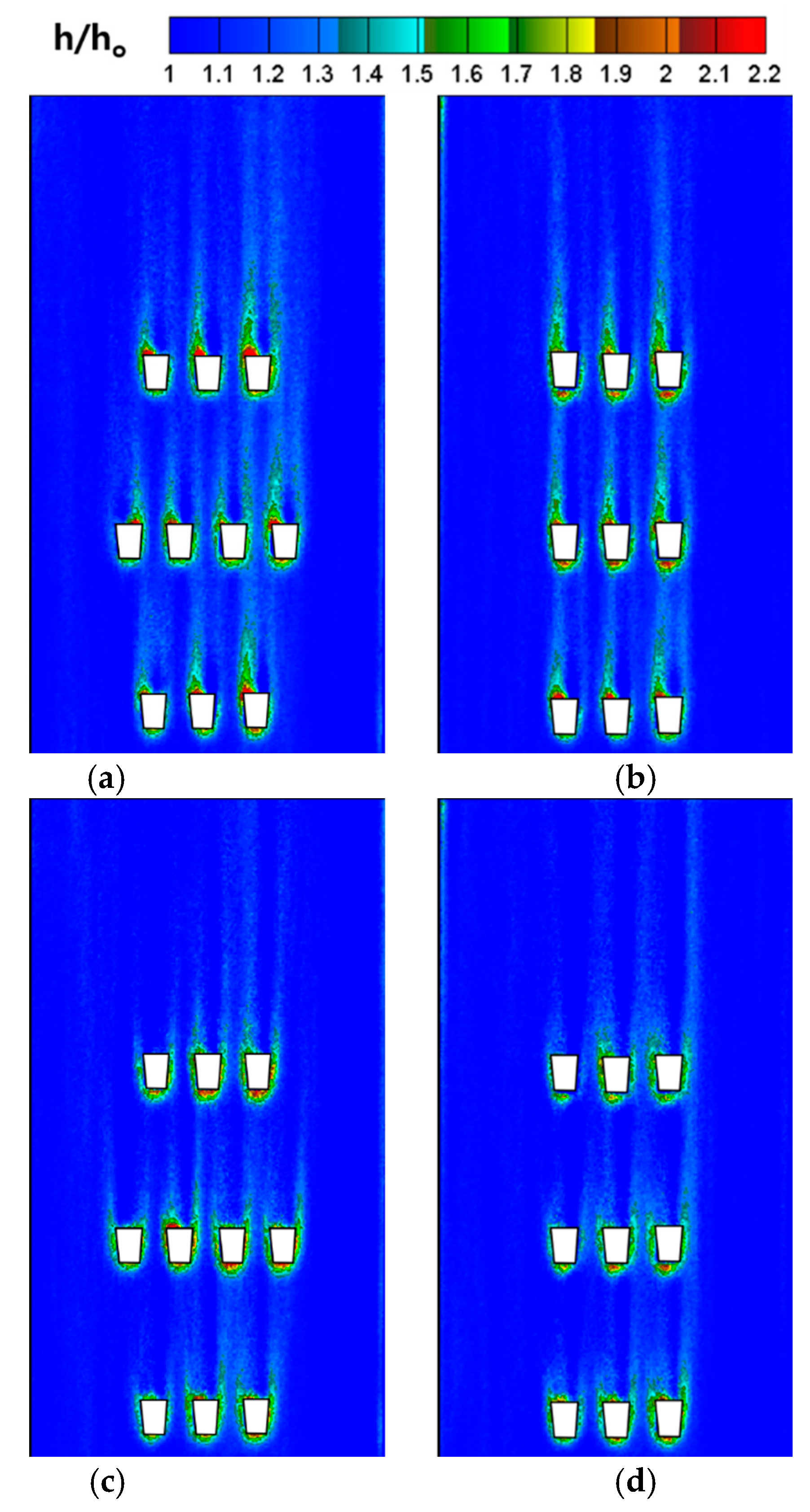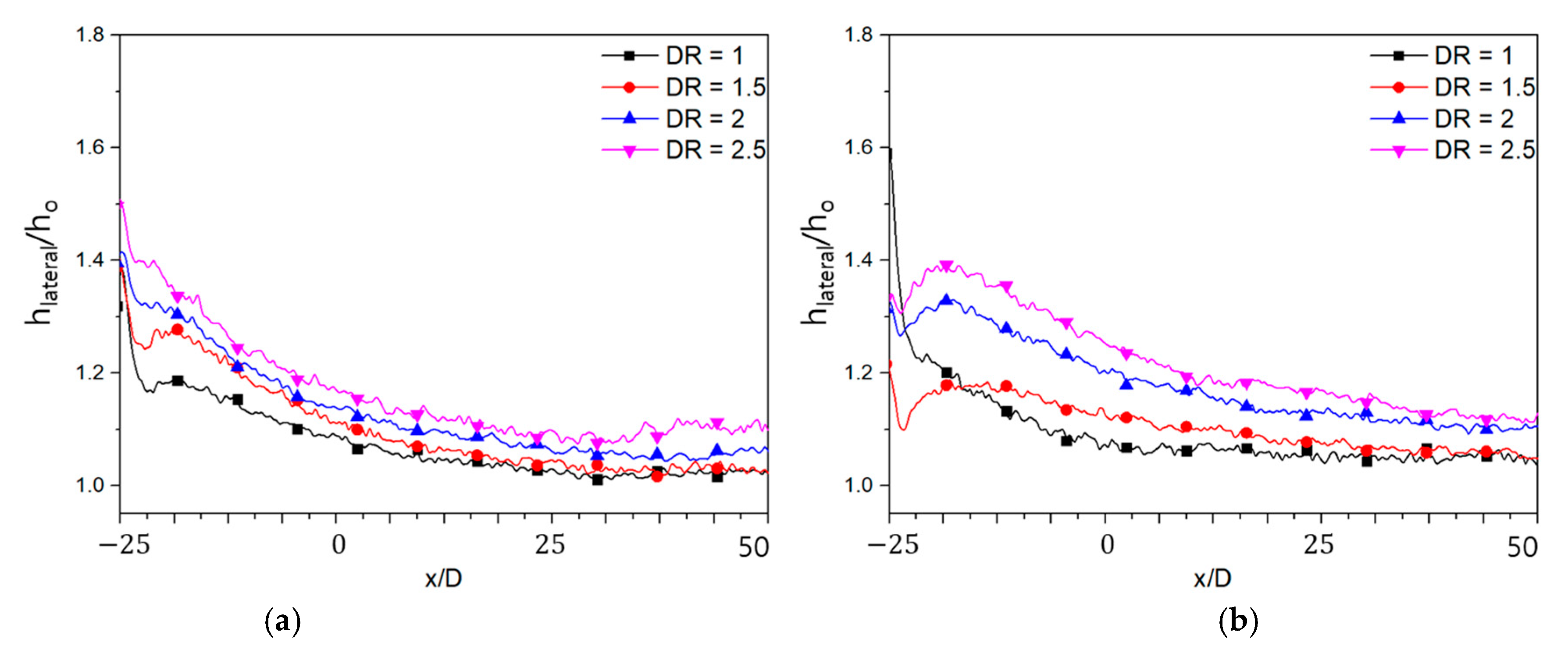The Effects of Hole Arrangement and Density Ratio on the Heat Transfer Coefficient Augmentation of Fan-Shaped Film Cooling Holes
Abstract
1. Introduction
2. Experimental Setup and Theory
2.1. Experiment Setup
2.2. Theory
2.3. Experimental Conditions
2.4. Uncertainty Analysis
3. Results and Discussion
3.1. Effect of Hole Pitch
3.2. Effect of Row-to-Row Distance
3.3. Arrangement Effects
3.4. Effect of Density Ratio (DR)
4. Conclusions
- At M = 1.0, the effects of the hole pitch were not considerable. At M = 2.0, an increased heat transfer coefficient augmentation was observed for the smallest hole pitch case (p/D = 5).
- The effects of the row-to-row distance and the hole arrangement were not observed due to the relatively large row-to-row distance in the current study.
- In the measurement of the heat transfer coefficient augmentation with various DRs, the heat transfer coefficient increased as the velocity difference between the mainstream and coolant increased.
Author Contributions
Funding
Conflicts of Interest
Nomenclature
| Symbol | Abbreviation |
| D | hole diameter |
| DR | density ratio |
| Fo | Fourier number |
| h | heat transfer coefficient (W/m2·K) |
| k | thermal conductivity (W/m·K) |
| L | row-to-row distance |
| M | blowing ratio |
| p | hole pitch |
| q’’ | heat flux (W/m2) |
| t | time(s) |
| T | temperature (K) |
| TI | turbulence intensity (%) |
| U | velocity (m/s) |
| x | distance from the hole exit along flow direction (m) |
| z | distance from the surface along vertical direction (m) |
Greek Symbols
| Symbol | Abbreviation |
| α | thermal diffusivity (m2/s) |
| θ | injection angle (˚) |
| ρ | density (kg/m3) |
| η | film cooling effectiveness |
Subscripts
| Symbol | Abbreviation |
| c | coolant parameters |
| f | film parameters |
| i | initial condition |
| w | wall surface parameters |
| ∞ | free stream parameters |
References
- Jones, T. FILM COOLING. Int. J. Med. Mushrooms 2006, 7, 321–379. [Google Scholar] [CrossRef]
- Wright, L.M.; McClain, S.T.; Clemenson, M.D. Effect of Density Ratio on Flat Plate Film Cooling With Shaped Holes Using PSP. J. Turbomach. 2011, 133, 041011. [Google Scholar] [CrossRef]
- Afejuku, W.O.; Hay, N.; Lampard, D. The Film Cooling Effectiveness of Double Rows of Holes. J. Eng. Power 1980, 102, 601–606. [Google Scholar] [CrossRef]
- Zhang, C.; Wang, J.; Luo, X.; Song, L.; Li, J.; Feng, Z. Experimental Investigation on the Flat-Plate Film Cooling Enhancement Using the Vortex Generator Downstream for the Cylindrical Hole and Fan-Shaped Hole Configurations. ASME Paper No. 2019-GT-90671. In Proceedings of the ASME Turbo Expo, Phoenix, AZ, USA, 17–21 June 2019. [Google Scholar]
- Schroeder, R.P.; Thole, K.A. Effect of In-Hole Roughness on Film Cooling From a Shaped Hole. J. Turbomach. 2016, 139, 031004. [Google Scholar] [CrossRef]
- Schroeder, R.P.; Thole, K.A. Effect of High Freestream Turbulence on Flowfields of Shaped Film Cooling Holes. J. Turbomach. 2016, 138, 091001. [Google Scholar] [CrossRef]
- Bacci, T.; Picchi, A.; Facchini, B. Flat Plate and Turbine Vane Film-Cooling Performance with Laid-Back Fan-Shaped Holes. Int. J. Turbomach. Propuls. Power 2019, 4, 14. [Google Scholar] [CrossRef]
- Li, W.; Li, X.; Ren, J.; Jiang, H. Experimental investigation of wall thickness and hole shape variation effects on full-coverage film cooling performance for a gas turbine vane. Appl. Therm. Eng. 2018, 144, 349–361. [Google Scholar] [CrossRef]
- Hay, N.; Lampard, D.; Saluja, C.L. Effects of Cooling Films on the Heat Transfer Coefficient on a Flat Plate With Zero Mainstream Pressure Gradient. J. Eng. Gas Turbines Power 1985, 107, 105–110. [Google Scholar] [CrossRef]
- Yu, Y.; Yen, C.H.; Shih, T.I.P.; Chyu, M.K.; Gogineni, S. Film Cooling Effectiveness and Heat Transfer Coefficient Distributions Around Diffusion Shaped Holes. J. Heat Transf. 2002, 124, 820–827. [Google Scholar] [CrossRef]
- Bonanni, L.; Facchini, B.; Tarchi, L.; Maritano, M.; Traverso, S. Heat Transfer Performance of Fan-Shaped Film Cooling Holes: Part I—Experimental Analysis. In Heat Transfer, Parts A and B; ASME International: New York, NY, USA, 2010; Volume 4, pp. 1561–1571. [Google Scholar]
- Haydt, S.; Lynch, S. Heat Transfer Coefficient Augmentation for a Shaped Film Cooling Hole at a Range of Compound Angles. J. Turbomach. 2020, V05BT19A026, 1–30. [Google Scholar] [CrossRef]
- Anderson, J.B.; Bogard, D.G.; Dyson, T.E.; Webster, Z.D. Direct Experimental Measurements of Heat Transfer Coefficient Augmentation Due to Approach Flow Effects. J. Turbomach. 2019, 141, 031011. [Google Scholar] [CrossRef]
- Nikparto, A.; Rice, T.; Schobeiri, M.T. Experimental and Numerical Investigation of Heat Transfer and Film Cooling Effectiveness of a Highly Loaded Turbine Blade Under Steady and Unsteady Wake Flow Condition. ASME Paper No. 2017-GT-65012. In Proceedings of the ASME Turbo Expo, Charlotte, NC, USA, 26–30 June 2017. [Google Scholar]
- Fraas, M.; Glasenapp, T.; Schulz, A.; Bauer, H.-J. Film Cooling Measurements for a Laidback Fan-Shaped Hole: Effect of Coolant Crossflow on Cooling Effectiveness and Heat Transfer. J. Turbomach. 2019, 141, 041006. [Google Scholar] [CrossRef]
- Smith, D.E.; Bubb, J.V.; Popp, O.; Grabowski, H.; Diller, T.E.; Schetz, J.A.; Ng, W.F. An Investigation of Heat Transfer in a Film Cooled Transonic Turbine Cascade: Part I—Steady Heat Transfer. ASME Paper No. 2000-GT-0202. In Proceedings of the ASME Turbo Expo, Munich, Germany, 8–11 May 2000. [Google Scholar]
- Moffat, R.J. Describing the uncertainties in experimental results. Exp. Therm. Fluid Sci. 1988, 1, 3–17. [Google Scholar] [CrossRef]
- Boyd, E.J.; McClintic, J.W.; Chavez, K.; Bogard, D.G. Direct Measurement of Heat Transfer Coefficient Augmentation at Multiple Density Ratios. J. Turbomach. 2016, 139, 011005. [Google Scholar] [CrossRef]


















| Test Parameter | Test Condition |
|---|---|
| Mainstream Velocity | 20 m/s |
| Turbulence Intensity | 2.7% |
| Blowing Ratio (M) | 1.0, 2.0 |
| Density Ratio (DR) | 1.0, 1.5, 2.0, 2.5 |
| Boundary Layer Thickness | 6 mm |
| Arrangement | Hole Pitch (p/D) | Row-to Row Distance (L/D) | Blowing Ratio (M) | Density Ratio (DR) |
|---|---|---|---|---|
| Staggered | 5 | 25 | 1, 2 | 1 |
| Staggered | 7.5 | 25 | 1, 2 | 1 |
| Staggered | 10 | 25 | 1, 2 | 1 |
| Staggered | 7.5 | 20 | 1, 2 | 1 |
| Staggered | 7.5 | 30 | 1, 2 | 1 |
| Inline | 7.5 | 25 | 1, 2 | 1 |
| Single-Row | 7.5 | - | 1, 2 | 1, 1.5, 2.0, 2.5 |
| Coolant | DR | M | Velocity Ratio | Momentum Ratio |
|---|---|---|---|---|
| Air | 1 | 1 | 1 | 1 |
| 2 | 2 | 4 | ||
| CO2 | 1.5 | 1 | 0.666 | 0.666 |
| 2 | 1.333 | 2.667 | ||
| SF6 25%+N2 75% | 2.0 | 1 | 0.5 | 0.5 |
| 2 | 1 | 2 | ||
| SF6 38%+N2 62% | 2.5 | 1 | 0.4 | 0.4 |
| 2 | 0.8 | 1.6 |
Publisher’s Note: MDPI stays neutral with regard to jurisdictional claims in published maps and institutional affiliations. |
© 2021 by the authors. Licensee MDPI, Basel, Switzerland. This article is an open access article distributed under the terms and conditions of the Creative Commons Attribution (CC BY) license (http://creativecommons.org/licenses/by/4.0/).
Share and Cite
Kim, Y.S.; Jeong, J.Y.; Kwak, J.S.; Chung, H. The Effects of Hole Arrangement and Density Ratio on the Heat Transfer Coefficient Augmentation of Fan-Shaped Film Cooling Holes. Energies 2021, 14, 186. https://doi.org/10.3390/en14010186
Kim YS, Jeong JY, Kwak JS, Chung H. The Effects of Hole Arrangement and Density Ratio on the Heat Transfer Coefficient Augmentation of Fan-Shaped Film Cooling Holes. Energies. 2021; 14(1):186. https://doi.org/10.3390/en14010186
Chicago/Turabian StyleKim, Young Seo, Jin Young Jeong, Jae Su Kwak, and Heeyoon Chung. 2021. "The Effects of Hole Arrangement and Density Ratio on the Heat Transfer Coefficient Augmentation of Fan-Shaped Film Cooling Holes" Energies 14, no. 1: 186. https://doi.org/10.3390/en14010186
APA StyleKim, Y. S., Jeong, J. Y., Kwak, J. S., & Chung, H. (2021). The Effects of Hole Arrangement and Density Ratio on the Heat Transfer Coefficient Augmentation of Fan-Shaped Film Cooling Holes. Energies, 14(1), 186. https://doi.org/10.3390/en14010186






